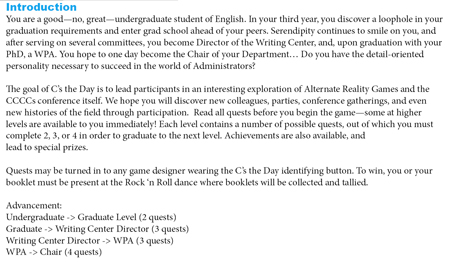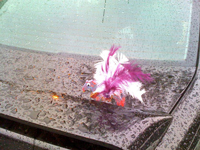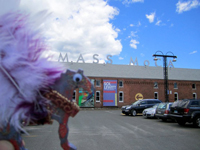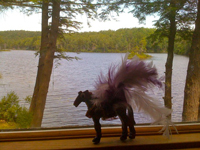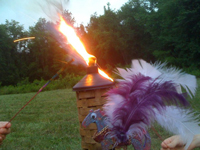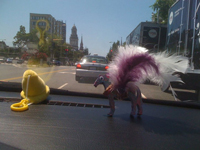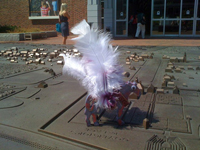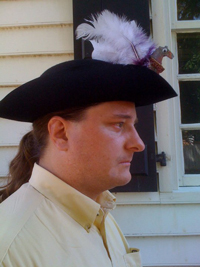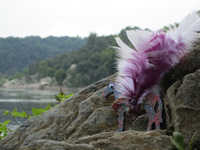Part 2: The Game
2.1: Making the Game (Wendi)
C's the Day is a collaboratively developed game designed to engage people, particularly newcomers, at the Conference on College Composition and Communication. There are several game designers: Kelly Centrelli, Doug Eyman, Mary Karcher, Jill Morris, Scott Reed, Sheryl Ruszkiewicz, and of course, myself. One genesis of the game came from an inspiring presentation, titled “Press ‘Start’: Critical Reflections on the Development and Deployment of a Large-Scale Alternate Reality Game (ARG)” at the 2010 Computers and Writing conference. In that presentation, Amy C. Kimme Hea, Josh Zimmerman and Sara Howe reflected on their inventive use of augmented reality games in a literature classroom, drawing students into class assignments and online discussion through a carefully constructed storyline involving mystery, memory, and alien abduction. A series of games and writing workshops that began at the 2009 Conference on College Composition and Communication (developed by Jamie Bono, Alice Daer, Doug Eyman, Annette Vee, and Zach Waggoner with Suzanne Blum-Malley joining the team for the 2.0 version) also set the stage for the Cs the Day Game: the 2009 and 2010 versions of the workshop prototyped a small-scale conference game dubbed "Confarganon."
And so we began to brainstorm—could we use these ideas on a larger scale to raise the currency that games have in our field? Over the last several years, games have gained more visibility in major conferences in our field. At 4Cs, in addition to the individual panels that discuss games, there is a pre-conference workshop on games and composition and a Special Interest Group (SIG) about serious gaming. At the same time, quite often we see the usual suspects at panels, workshops, and in the SIG. Perhaps by creating our own augmented reality game to be played at the conference, we could subtly introduce the connection between games and learning to a wider audience. And, of course, it would be fun for us and (hopefully) for players.
With these ideas in mind, we designed a game to be played at the conference by anyone who felt like signing up. C’s the Day was meant to augment the player’s conference experience, encouraging them explore and make the most of their conference experience.
The game (http://cstheday.org) is a simple role-playing game in which players take on an identity and progress through the completion of relevant quests. Every player takes on the role of a newly enrolled graduate student. At the start of the game, they must decide their future, choosing between three distinct (for the purposes of the game) career paths. Once a path has been chosen, players received a booklet and a badge sticker that proudly proclaims Administrator, Professor, or Publisher. In order to win the game and to progress to such lofty heights as "department chair," "full professor," or even "Vice President of New Media," players had to complete a variety of quests. Along the way, players could win a small sparklepony—a wooden craft pony decorated with glitter, feathers, and googly eyes—and three winners would win the coveted giant sparkleponies.
The entire game booklet was available for free in the registration room at C's. The introduction text for the Administrator role was as follows (entire booklet available as a pdf here):
As a designer, I felt making the quests was both the most challenging and the most enjoyable part. We had so many ideas based on our own experiences at past 4Cs and experiences we've had in various academic positions. Many of these quests, though certainly not all, relate to a personal experience of one of the game designers. For me, the Magical Creed quest was one that had special resonance:
Wendi-story by kstedman
[Transcript: When I went to my first 4Cs, I was a 2nd-year masters student that had really just even found out about rhet and comp as a field, much less gotten into it. It was the year in New York, which I think only added both to my sense of awe and to being overwhelmed by everything that was going on. I really had no idea what I was doing or where I was going, and somehow I had managed to hear about one publisher party—I think maybe it was Pearson. Well, I went and I was floored. This publisher was giving me, a poor grad student with no clue what I was doing, appetizers! I had no idea this kind of thing even happened!
As I continued coming to the conference year after year, I found out about more little events like that: the Newcomer's Breakfast, the Rock and Roll Party, and of course all the other publisher parties. So when we were making the game, I wanted to be sure there would be something that would direct new people, people who were perhaps in the same spot I was in the first year, to some of those events. And so we came up with the Magical Creed quest: Receive a copy of a list of all the places where free food and alcohol can be gotten at the Cs.]
Most of the quests fall into one of four groupings:
- Some of these quests were directly related to their conference experience.
- Many quests asked players to network, encouraging them to meet other players and other conference goers.
- Some quests were meant to guide players to events that they might not have otherwise known about.
- And of course, some were made purely for entertainment.
While I hesitate to speak for all of the organizers, I can say that I was motivated to participate in this project for two reasons. The first, and perhaps clearest, benefit to the game is that it creates what Gee (2003) might call an affinity group within the conference, providing guidance to newcomers. It encourages social interaction and can act as the catalyst for scholars, veteran and rookie, to have a conversation.
In addition to helping conference attendees find an inviting space in the middle of our constantly growing conference, I had another motivation. As a scholar with interests in gaming, I feel strongly that C's the Day can be a positive ambassador for games and learning. I hope that, in addition to playing and enjoying our game, players will reflect on how the game did precisely what Gee suggested that good games do: provide players with a sense of control in the overwhelmingly large (and sometimes isolating) conference environment, give them agency to choose their actions and take actions that mattered, and help them understand the meaningfulness of the conference itself—not as an abstraction, but as a lived, meaningful event.
2.2: Playing the Game (Kyle)
I won because of my haiku. No, really. At a critical moment on the last night of C’s the Day, when I was about to give up, I wrote two successive tweets:
Up to that point, I had been playing the game with varying degrees of intensity. I would wake up and think, “Ugh, there’s no way I got enough stamps yesterday. Should I play today?” (Or as I tweeted one day, “Got promoted to graduate student level in #cstheday but still feel woefully behind. At least I'll get a stamp at the Bedford party!”) But still, I would rush to the Twitter feed, where, thank goodness, there didn’t seem to be too much activity since I had gone to bed. And flipping through my game booklet, I would see that I could easily score three stamps before lunch—and then I was back in it again.
But on the last night of the game, just before I wrote my haiku, my indecision was more intense than usual. I was ready to give up completely. Not just out of desperation—though I was sure I had no chance of winning—but because of my community of friends. I was staying at an Atlanta friend’s house, and I hated the idea of asking her to pick me up at the MARTA station so late after attending the Rock ‘n Roll Dance where the game would finally culminate in a boss battle of outfits and dance-floor moves. None of my closest friends were playing as hardcore as I was, so I’d be going to the party alone. Faced with the decision between playing full-force alone, which meant attending the party, or staying comfortably put in my social circles, the friendship angle was winning. We know this: that motivation is social. Part of agency is wrapped up in a mélange of peer pressure, social obligation, and the desire to not be a pain in anyone’s ass. At that moment at C’s, I felt torn, unable to act.
Even worse: I had never scored a small sparklepony by completing the “Corporate Whore” quest:
This was entirely my fault. When I sauntered through the mall store looking for swag, everything seemed like a waste of money or like it would be quickly re-gifted. But I felt the lack of the sparklepony; how could I win without one? Maybe its influence is what I needed to push me to act, if I could have seen its wide eye (only one visible at a time) staring at me with a face asking, “You said we were in this together. How could you leave me?”
So, gripped with indecision, I tweeted my desire for the pony, using haiku to reflect the musical, nondiscursive form of my emotions. (Or something like that.) And when the haiku were done—written on my laptop in the middle of a group of socializing friends in the hotel lobby discussing what to do instead of the Rock ‘n Roll Dance—I decided it was time to win. Just like that. I called my friend and asked her to pick me up late again, apologized to my buddies, and trampsed down the stairs to the ballroom to find . . .
. . . the entire group of C’s the Day game organizers gushing over my haiku. They had a laptop open in the dark of the party, Vanilla Ice blaring in the background, reading #cstheday tweets in real time. Right then, everything changed for me. They agreed immediately to grant me the pony in exchange for the haiku (!), something I had never expected; it was like finding a warp zone I didn’t know was there. There in the half light, they helped me scour my book for other stamps I could earn. Tell them a story about my students? That would get me “Kayak Down the Stairs”! Take pictures of others with my new sparklepony? An instant “Sparklepony Bomb” quest, completed on the spot! Find someone else to write more sparklepony haiku? That could earn me the “Make a Meme” quest! I frantically rushed around, collecting handwritten haiku, forgetting in my sweatiness just how recently I had planned to skip this entire, soul-enlargening event, which I now loved more than anything I had ever loved.
Suddenly, my social group had shifted to include this new group of game players and game administrators. And that made all the difference. It was a shadow-taste of this community-driven motivation that I had been looking for when scouring the Twitter feed each morning of the conference, but this was the real thing: people who urged me to succeed, to play, to win.
Let me tell the story of what happened next in my own words, again emphasizing the social aspect of the game.
Kyle-story by kstedman
[Transcript: So throughout my Cs experience, everyone kept asking me about my nametag. There were so many stickers on it, partly because I went to a pre-conference workshop, and partly because every time I advanced in the C’s the Day game, I got another sticker on it. And that was awesome. So everywhere I went, my friends would say, “Wait, do you have a little bit more on there than you used to? What in the world is going on?” I would tell them, of course, and eventually it turned into a, “Hey Kyle! Tell us about the game! Tell us what you’re doing right now. Tell us what crazy thing. Oh, ha ha, it’s so funny!”
So those conversations continued on the drive home—a group of us had driven up to Atlanta from Florida. And in the car, as we talked about C’s the Day, the more we realized we needed something like that for our teacher orientation for the First-Year Composition program at USF. Every year we schedule a two-week orientation that includes old teachers and new teachers. So there’s people who have been adjuncting for ten years alongside people who are brand new in the MA in literature, rhet/comp, or MFA programs. People who have never taught before and who have lots of teaching experience. And one of the primary goals of the orientation is to get all of these people together in a room and share what they know—share their hopes, their fears, their resources, things like that, to help everyone be better teachers together. So the social aspect of something like C’s the Day was exactly what we thought we needed to bring that umph to orientation.]
Previous: What is Gamification? | Next: The Next Generation
